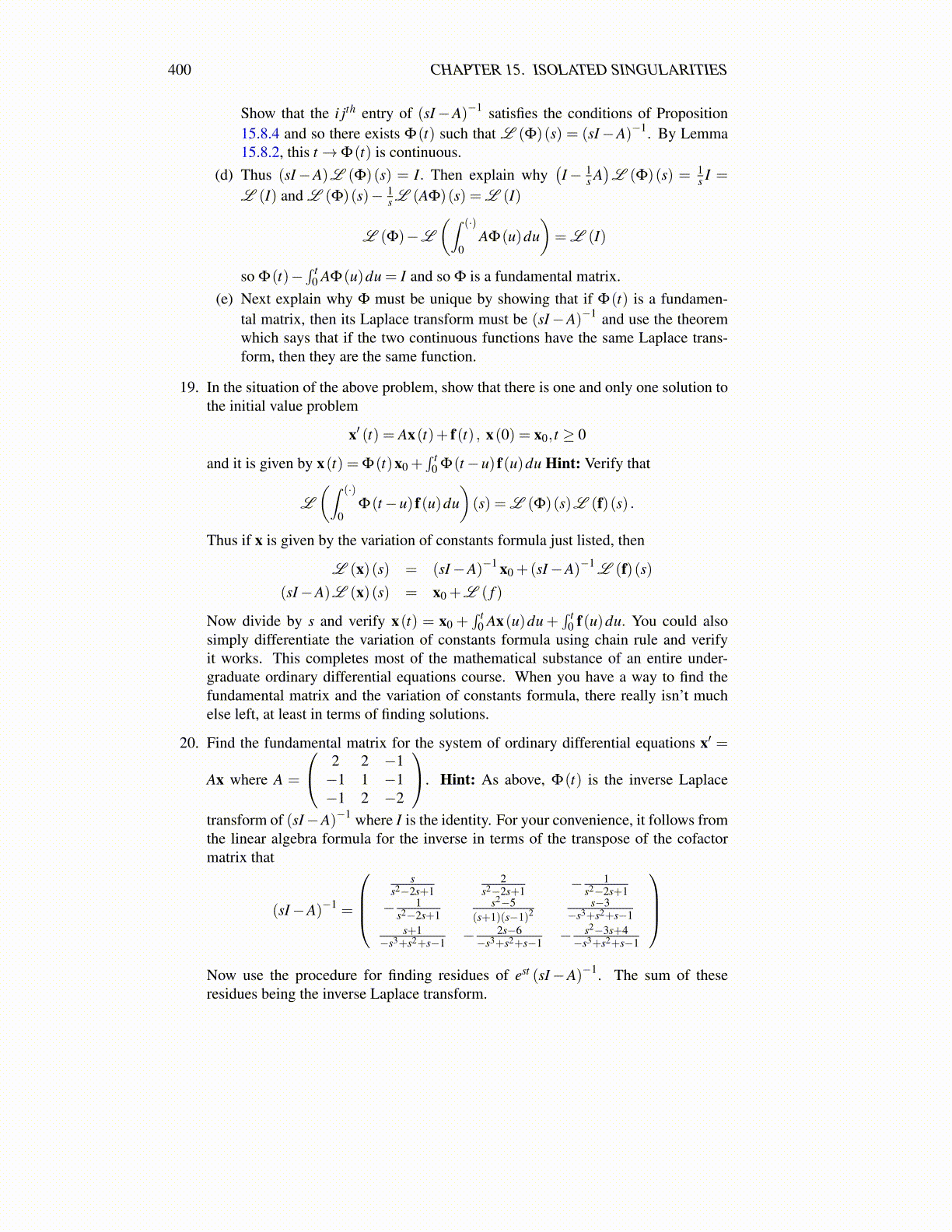
400 CHAPTER 15. ISOLATED SINGULARITIES
Show that the i jth entry of (sI−A)−1 satisfies the conditions of Proposition15.8.4 and so there exists Φ(t) such that L (Φ)(s) = (sI−A)−1. By Lemma15.8.2, this t→Φ(t) is continuous.
(d) Thus (sI−A)L (Φ)(s) = I. Then explain why(I− 1
s A)L (Φ)(s) = 1
s I =
L (I) and L (Φ)(s)− 1s L (AΦ)(s) = L (I)
L (Φ)−L
(∫ (·)
0AΦ(u)du
)= L (I)
so Φ(t)−∫ t
0 AΦ(u)du = I and so Φ is a fundamental matrix.(e) Next explain why Φ must be unique by showing that if Φ(t) is a fundamen-
tal matrix, then its Laplace transform must be (sI−A)−1 and use the theoremwhich says that if the two continuous functions have the same Laplace trans-form, then they are the same function.
19. In the situation of the above problem, show that there is one and only one solution tothe initial value problem
x′ (t) = Ax(t)+ f(t) , x(0) = x0, t ≥ 0
and it is given by x(t) = Φ(t)x0 +∫ t
0 Φ(t−u) f(u)du Hint: Verify that
L
(∫ (·)
0Φ(t−u) f(u)du
)(s) = L (Φ)(s)L (f)(s) .
Thus if x is given by the variation of constants formula just listed, then
L (x)(s) = (sI−A)−1 x0 +(sI−A)−1 L (f)(s)(sI−A)L (x)(s) = x0 +L ( f )
Now divide by s and verify x(t) = x0 +∫ t
0 Ax(u)du +∫ t
0 f(u)du. You could alsosimply differentiate the variation of constants formula using chain rule and verifyit works. This completes most of the mathematical substance of an entire under-graduate ordinary differential equations course. When you have a way to find thefundamental matrix and the variation of constants formula, there really isn’t muchelse left, at least in terms of finding solutions.
20. Find the fundamental matrix for the system of ordinary differential equations x′ =
Ax where A =
2 2 −1−1 1 −1−1 2 −2
. Hint: As above, Φ(t) is the inverse Laplace
transform of (sI−A)−1 where I is the identity. For your convenience, it follows fromthe linear algebra formula for the inverse in terms of the transpose of the cofactormatrix that
(sI−A)−1 =
s
s2−2s+12
s2−2s+1 − 1s2−2s+1
− 1s2−2s+1
s2−5(s+1)(s−1)2
s−3−s3+s2+s−1
s+1−s3+s2+s−1 − 2s−6
−s3+s2+s−1 − s2−3s+4−s3+s2+s−1
Now use the procedure for finding residues of est (sI−A)−1. The sum of theseresidues being the inverse Laplace transform.